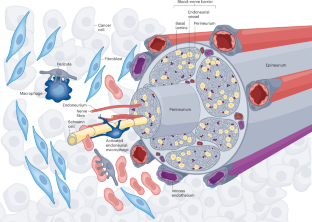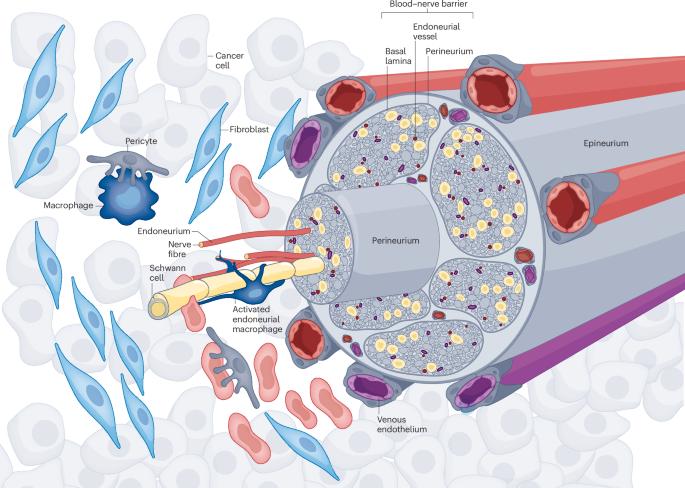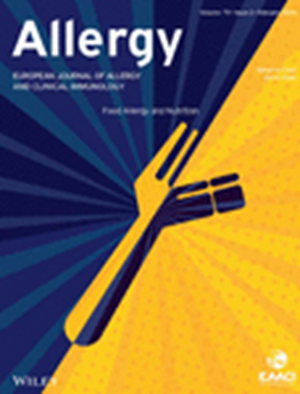Targeting the peripheral neural-tumour microenvironment for cancer therapy
IF 12.6
1区 医学
Q1 ALLERGY
引用次数: 0
Abstract
As the field of cancer neuroscience expands, the strategic targeting of interactions between neurons, cancer cells and other elements in the tumour microenvironment represents a potential paradigm shift in cancer treatment, comparable to the advent of our current understanding of tumour immunology. Cancer cells actively release growth factors that stimulate tumour neo-neurogenesis, and accumulating evidence indicates that tumour neo-innervation propels tumour progression, inhibits tumour-related pro-inflammatory cytokines, promotes neovascularization, facilitates metastasis and regulates immune exhaustion and evasion. In this Review, we give an up-to-date overview of the dynamics of the tumour microenvironment with an emphasis on tumour innervation by the peripheral nervous system, as well as current preclinical and clinical evidence of the benefits of targeting the nervous system in cancer, laying a scientific foundation for further clinical trials. Combining empirical data with a biomarker-driven approach to identify and hone neuronal targets implicated in cancer and its spread can pave the way for swift clinical integration. Targeting the interactions between neurons, cancer cells and other elements in the tumour microenvironment represents a potential paradigm shift in cancer treatment. This Review article provides an overview of the dynamics of the nerve–cancer cell interplay as well as a discussion of current preclinical and clinical evidence of the benefits of targeting the nervous system in cancer.


针对外周神经-肿瘤微环境的癌症疗法
随着癌症神经科学领域的不断扩展,对神经元、癌细胞和肿瘤微环境中其他元素之间的相互作用进行战略性靶向治疗,代表着癌症治疗的潜在范式转变,堪比我们目前对肿瘤免疫学的理解。癌细胞会主动释放生长因子,刺激肿瘤新神经元的生成,越来越多的证据表明,肿瘤新神经元会推动肿瘤的进展,抑制与肿瘤相关的促炎细胞因子,促进新生血管生成,促进肿瘤转移,并调节免疫耗竭和免疫逃避。在这篇综述中,我们将概述肿瘤微环境的最新动态,重点介绍肿瘤受外周神经系统支配的情况,以及目前临床前和临床证据表明靶向神经系统治疗癌症的益处,为进一步的临床试验奠定科学基础。将经验数据与生物标志物驱动的方法相结合,以确定和磨练与癌症及其扩散有关联的神经元靶点,可以为快速临床整合铺平道路。
本文章由计算机程序翻译,如有差异,请以英文原文为准。
求助全文
约1分钟内获得全文
求助全文
来源期刊

Allergy
医学-过敏
CiteScore
26.10
自引率
9.70%
发文量
393
审稿时长
2 months
期刊介绍:
Allergy is an international and multidisciplinary journal that aims to advance, impact, and communicate all aspects of the discipline of Allergy/Immunology. It publishes original articles, reviews, position papers, guidelines, editorials, news and commentaries, letters to the editors, and correspondences. The journal accepts articles based on their scientific merit and quality.
Allergy seeks to maintain contact between basic and clinical Allergy/Immunology and encourages contributions from contributors and readers from all countries. In addition to its publication, Allergy also provides abstracting and indexing information. Some of the databases that include Allergy abstracts are Abstracts on Hygiene & Communicable Disease, Academic Search Alumni Edition, AgBiotech News & Information, AGRICOLA Database, Biological Abstracts, PubMed Dietary Supplement Subset, and Global Health, among others.
 求助内容:
求助内容: 应助结果提醒方式:
应助结果提醒方式:


